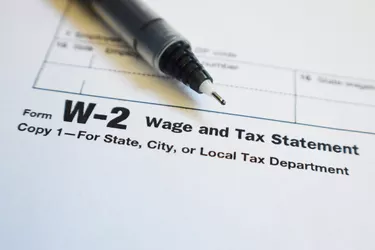
When you join a union that's part of your employment, you will be tasked with paying a certain amount of union dues on your paycheck, usually every pay period. In most cases, these dues amount to 1 to 2 percent of your paycheck. If you're trying to identify union dues for your tax return or want to know how much union dues were deducted from your paycheck, you should understand where to find this information on a pay stub or your W-2 form.
Union Dues on W-2 and Pay Stubs
Video of the Day
When you receive a paycheck, your employer is required to display any union dues on the pay stub. These dues reflect only how much money was collected for that specific pay period. Your W-2 union dues will be placed on the W-2 earning statement that you receive at the end of the year.
Video of the Day
Keep in mind that union dues are applied to your paycheck only after any tax deductions have occurred. As such, these deductions don't change how your income taxes are calculated. While your pay stub or W-2 earning statement may contain an extensive amount of information, finding your union deductions is simple.
The first thing you need to do is locate a recent W-2 form or pay stub, after which you'll be able to search for the amount of union dues that you've paid.
Locate Pay Stub Deductions Section
On your pay stub will be a pay-stub deductions section, which shows you all the money that was taken out of your paycheck before it was given to you. The union dues that you've paid should be displayed in a section titled "Miscellaneous Deductions," which differs from the tax deductions section. In this area, you'll likely notice the word "Dues" or the name of the union you belong to. Right next to this particular entry should be the exact amount of dues that you paid for the previous pay period.
As mentioned previously, union dues are considered post-tax. Some businesses will use more modern and informative pay stubs that include the amount of dues you've paid to date for the current year, which can be helpful when calculating if the right amount of money was taken out of your paycheck.
Find Information in Box 14
Union fees are located in box 14 of your W-2. Any amount of money in box 14 will affect your pay but not your taxable income. Before the Tax Cuts and Jobs Act was passed in 2017, union fees could be deducted on your taxes. Once this bill was passed, however, union fee deductions were eliminated through 2025. So, even if you're able to itemize your deductions, union fees are still unable to be deducted.
While standard employees don't have the ability to deduct their union fees, the same isn't true of self-employed individuals. If you are currently self-employed yet still pay union dues, you can deduct these dues as a standard business expense. Keep in mind that certain states allow employee expenses like union dues to be deducted from a state tax return, which include Pennsylvania and Minnesota.
When you join any union, you're expected to pay union dues to remain a member. While it can be frustrating to have these fees taken out of your paycheck, most unions provide members with numerous benefits that should essentially cover the costs of being a union member. Knowing where to locate union deductions on a pay stub or W-2 will allow you to understand why your annual income is what it is.